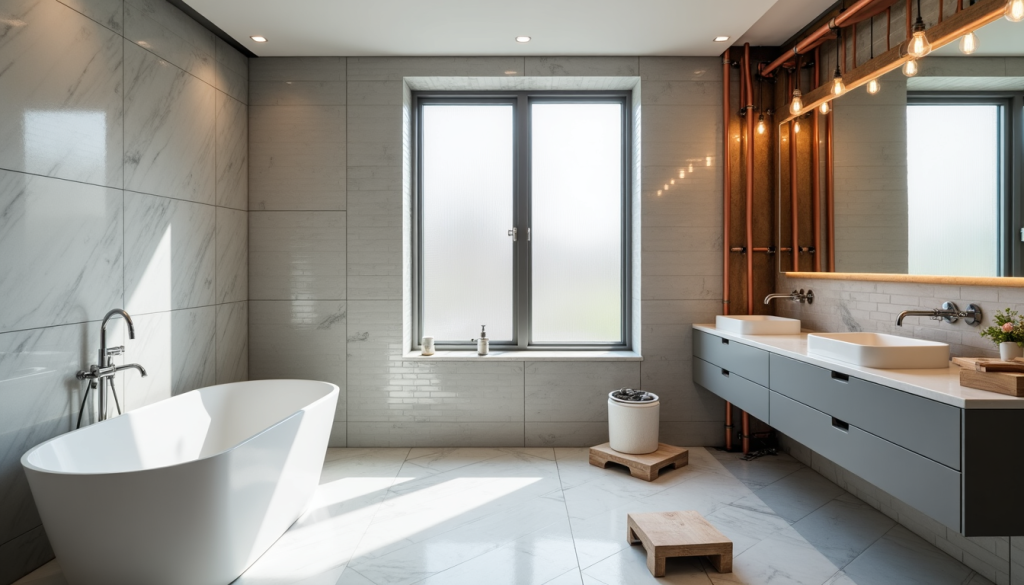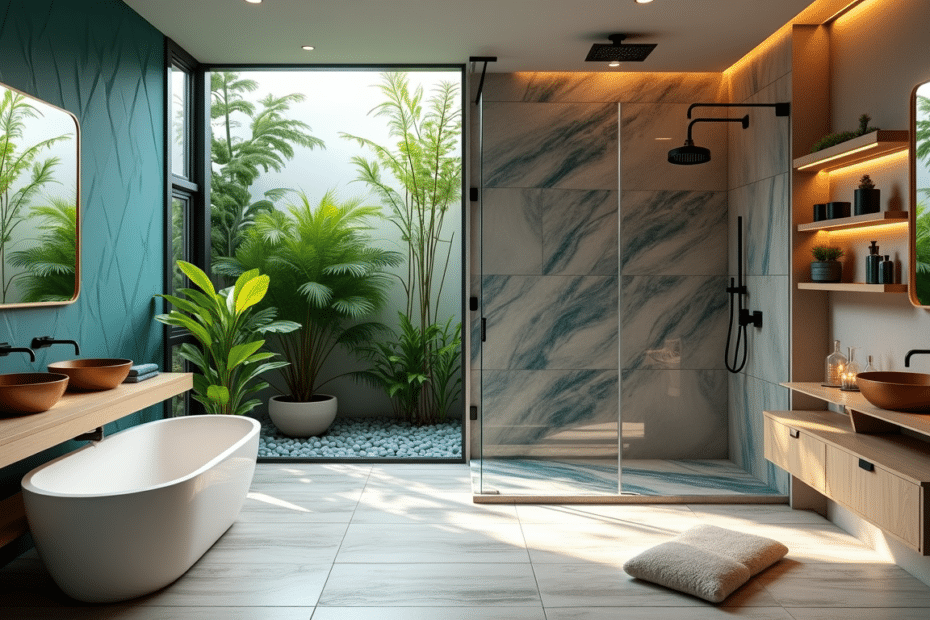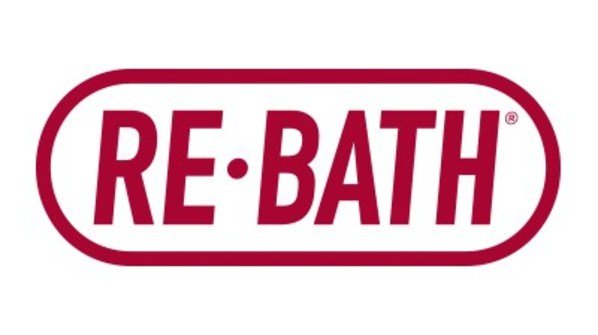Bathrooms in 2025 are no longer just functional spaces. These personal spaces have evolved into wellness sanctuaries that revolutionize our daily routines. Traditional all-white designs are fading away. Bold patterns, colorful marble, and nature-inspired elements now define modern bathroom concepts.
These changes are way beyond the reach and influence of simple style updates. Modern bathrooms now blend smart technology with sustainability. You’ll find app-controlled toilets and water-saving fixtures that make a real difference. The rise of biophilic design stands out especially when you have natural elements and greenery that create a spa-like atmosphere. This piece explores why these unexpected trends are the foundations of our personal spaces and how they reflect broader changes in home wellness thinking.
The Cultural Shift Behind Modern Bathroom Trends
Our relationship with bathrooms has changed dramatically in 2025. What used to be purely functional spaces have now become something much more meaningful. Let’s look at what’s driving these changes in bathroom trends today.
How pandemic living changed our bathroom priorities
The COVID-19 pandemic changed how we look at bathrooms forever. This change has left a lasting effect on design priorities. Our homes became our whole world during lockdowns. People started to value spaces they barely noticed before. Bathrooms turned into sanctuaries during these tough times.
Research shows that 82% of Americans want touchless fixtures in public restrooms. This focus on hygiene has spread to homes, where people now ask for these same features in their personal bathrooms.
The pandemic didn’t just change what we wanted in bathrooms—it changed how we feel about them. One design expert put it perfectly: “The shift that happened during and after covid is the word and term ‘feel’. How we feel in the space, whether in the home in general or just in the bathroom, became more present in the conversation”.
Bathrooms have become crucial to our self-care routines. Zillow’s data backs this up – real estate listings that mention wellness features increased by 16% year-over-year in 2024. This shows how these changes affect property values directly.
The rise of wellness culture in home design
Wellness is now the life-blood of modern bathroom design. The National Kitchen & Bath Association’s 2025 Bath Trend Report confirms this change. Three out of five design professionals say bathrooms should feel “relaxed/retreat-like” or “spa-like”. Plus, 52% say homeowners want these spaces to work as “places of healthy living and wellness”.
This all-encompassing approach to wellness shows up in many ways:
- Showers with aromatherapy that fill the space with calming scents like lavender or eucalyptus
- Lighting that uses different colors to boost mental states
- Steam features and soaking tubs that help with physical recovery and relaxation
Self-care has moved from an occasional treat to a daily need. Now 90% of homeowners want their main bathrooms to be retreats where they can unwind and recharge.
Modern bathrooms do more than help people relax. About 72% of clients use their showers for rehabilitation with features like steam and aromatherapy. Another 70% see soaking tubs as tools for healing and recovery.
Social media’s influence on bathroom esthetics
Instagram and other social platforms have revolutionized bathroom design trends. Social media apps pushed establishments to make their bathrooms showcase style and personality. They hoped their “Instagrammable” spaces would create buzz and draw more customers.
This trend has reached homes too. Homeowners now see bathrooms as chances to express themselves. Bold patterns, vibrant colors, and unique fixtures are back because bathrooms aren’t just functional spaces anymore – they’re statement pieces.
Today’s designs focus on nature-inspired forms, nostalgic touches, personal style, and smart technology. “Playful nostalgia” leads the way, bringing back classical and retro-inspired designs.
Plain white bathrooms are stepping aside for more expressive looks. Bold coverings, patterned tiles, and custom vanities let homeowners break free from standard designs and add their personal touch.

Why Sustainability Is Driving Bathroom Innovation
Bathroom trends are changing fast as homeowners realize their choices affect both the planet and their wallets. Modern bathroom breakthroughs go beyond just looks. They serve a deeper purpose by combining environmental awareness with real benefits.
Water conservation features gaining popularity
Water-saving fixtures have moved from a specialty item to a must-have in modern bathrooms. New low-flow showerheads and faucets with state-of-the-art technology use much less water than older models. They still deliver great performance and comfort. To cite an instance, advanced EcoSmart technologies can reduce water consumption by up to 60% compared to standard fixtures.
Dual-flush toilets stand out as another game-changing breakthrough. These smart systems offer two options: a smaller flush (0.8 to 1.1 gallons) for liquid waste and a larger one (about 1.6 gallons) for solid waste. This simple yet clever design can save thousands of gallons yearly in each home.
Smart water management systems have changed how we track and control water use. Latest leak detection systems can spot tiny drips from faucets, shower heads, and pipes. They send alerts straight to your phone and can shut off water automatically when needed. These systems help solve a big problem. Replacing an old toilet (pre-1994) with a new 1.6-gallon-per-flush model can save between 7,900 and 21,700 gallons of water yearly in a typical home.
Eco-friendly materials replacing traditional options
Bathroom materials have seen amazing changes as green alternatives take over. So homeowners now prefer:
- Natural materials: Bamboo, ceramic, and natural stone last long with minimal environmental harm
- Recycled components: Steel (among the most recycled materials worldwide), concrete with recycled elements, and repurposed fixtures
- Reclaimed wood: This choice supports eco-friendly practices by cutting new timber needs and reducing deforestation
Green awareness goes beyond what you can see. It includes budget-friendly flooring like non-PVC options, cork, and responsibly harvested wood. Many manufacturers now create bathroom furniture from recycled materials. This shows how great design and eco-friendly practices work together perfectly.
The surprising economics of sustainable bathrooms
Sustainability’s growing influence on bathroom breakthroughs comes with unexpected financial benefits. Many homeowners worried green options would cost too much, but reality tells us something different.
Renovation companies like Bathfitter and Rebath report 71% of people try harder to cut their energy and water use compared to two years ago. British consumers will pay up to 25% more for eco-friendly products – that’s one in three people. They understand the long-term savings. Water-efficient bathrooms substantially lower utility bills through reduced water use and cheaper water heating costs.
Smart features like CoolStart faucets show these money-saving benefits. They ensure warm water flows only when you need it, which cuts energy costs. Underfloor heating works better than radiators. It gives more comfort and reduces energy bills.
Sustainable bathrooms boost your property’s value too. Current Zillow data shows homes with eco-friendly features listed in their description sell for more money. This reflects the growing market demand for green homes. High-quality sustainable products also last longer, which means you won’t need to replace them as often.
Technology Integration: Beyond Novelty to Necessity

Image Source: https://pixabay.com/
Technological innovations have become vital elements in current bathroom trends, not just futuristic novelties. The way we view bathroom tech has changed from luxury additions to what we now call necessary components. This transformation shows how our relationship with personal spaces continues to evolve.
Smart mirrors and digital controls
Modern bathroom ideas now center around the dramatically evolved bathroom mirror as a multifunctional hub. Smart mirrors now come packed with features that make life easier and more convenient:
- Display live updates including weather, news, and calendar events
- LED lighting with customizable brightness and anti-fog technology
- Skin condition analysis with individual-specific skincare advice
- Voice control options that work hands-free
These intelligent reflectors do more than help with appearance—they serve practical purposes with antimicrobial properties and energy efficiency. “Smart mirrors are amazing for storage, illumination, USB sockets and even wireless charging,” notes one industry expert.
Digital shower controls mark another leap in bathroom technology. Users can now set precise water temperatures and create personalized flow patterns that suit different household members. Smart showers connect to smartphone apps, letting you start your shower remotely or set specific routines. These systems remember your priorities, so you won’t have to struggle to find the right temperature daily.
Water and energy management systems
Smart bathroom technology now exceeds simple convenience to address resource conservation. Water management systems can spot leaks early, which saves thousands in potential repair costs. Homeowners get smartphone alerts about moisture changes or unusual water flow patterns from these discrete devices.
Digital faucets play their part in saving water through motion sensing and temperature regulation. One manufacturer puts it this way: “These smart monitors help save water (and money), and you can have the controls integrated with a voice assistant, like Siri or Alexa”.
Smart ventilation systems with humidity sensors adjust automatically based on bathroom conditions, adding to energy efficiency. Programmable heated floors run only when needed, which cuts down on wasted energy.
How tech is making bathrooms more available
The sort of thing I love about bathroom technology is how it improves accessibility if you have mobility challenges or disabilities. Touchless fixtures remove the need to operate things manually, which helps people with limited dexterity. Motion-activated faucets, toilets, and lighting create spaces where physical limitations matter less.
Voice-controlled systems are a game-changer in bathroom accessibility. Users can control showers, adjust lighting, or manage music through simple voice commands. This means people with mobility restrictions can stay independent in their personal care routines.
Smart height-adjustable fixtures and grab bars with built-in sensors add safety features that automatically alert caregivers about falls. These innovations show how technology has grown from novelty items to solutions that address basic human needs.
The Psychology of Color’s Comeback in Bathrooms
Colors have made a comeback in modern bathrooms and challenged the dominance of all-white and neutral spaces. This dynamic move in current bathroom trends shows how our emotional responses to color shape our most private spaces.
Why neutral-only bathrooms are disappearing
White and beige bathrooms’ popularity continues to fade as homeowners choose more expressive designs. Neutral-only bathrooms were once called timeless and versatile, but now they face competition from bold alternatives that bring emotional and esthetic benefits. People want bathrooms that spark specific feelings rather than just looking clean.
Neutral tones still play a role, but they’ve grown beyond plain whites. Earthy neutrals like beige, taupe, and warm gray add a touch of elegance and warmth. Bold colors now serve as thoughtful contrast elements in simple, natural bathrooms. This progress shows a complete reimagining of modern bathroom’s essence.
How color affects mood in personal spaces
Bathroom colors’ psychological effects reach way beyond the reach and influence of simple decoration. Each color actively shapes our emotional experience in these private spaces.
Blues and greens create calm and serenity that simulate nature’s soothing qualities. Warm colors like yellows and oranges generate energy and enthusiasm naturally. Morning bathrooms benefit from energizing warm tones, while evening relaxation spaces work better with cooler palettes.
Bathroom colors can reshape our daily routines completely. Pink creates feelings of nurture and femininity, while sophisticated grays showcase sleek sophistication. Green offers balance and refreshment to those seeking rejuvenation, and yellow brings joy and optimism.
The unexpected return of retro bathroom colors
Current bathroom trends show a surprising revival of vintage color schemes. The 1950s’ pastels have returned – mint green, baby blue, and blush pink. Bold 1970s palettes featuring mustard yellows, burnt oranges, and warm browns have also made their way back.
This color renaissance lets homeowners express creativity that neutral-dominated designs lacked. Modern retro-inspired bathrooms balance nostalgic elements with contemporary esthetics instead of copying historical designs exactly. Homeowners can create spaces that feel both familiar and fresh through smart color placement.
Nature-Inspired Elements Transforming Modern Bathrooms
Homeowners in 2025 want to bring nature into their bathrooms. This connection with the natural world has changed how we design and use modern bathrooms completely.
Biophilic design principles in bathroom spaces
Our natural connection to nature, biophilia, shapes today’s bathroom breakthroughs. Modern bathrooms blend natural elements with built spaces to support our health and wellbeing. These spaces create multi-sensory experiences that let us see, hear, smell, and feel nature around us.
Modern bathrooms now feature these essential elements:
- Large plants that clean the air and look beautiful
- Windows and skylights that let in natural light
- Water features with soothing sounds
- Natural patterns and textures that remind us of outdoor spaces
These features do more than just look good. They help reduce stress and boost our wellbeing, turning regular bathrooms into peaceful retreats.
Natural materials creating sensory experiences
Bathroom design now focuses on real, touchable materials. Stone, wood, and other natural surfaces have replaced artificial options. Matte finishes and unique shapes work together beautifully, while mineral plasters offer a continuous, moisture-controlling alternative to regular tiles.
Vanities made from reclaimed wood showcase nature’s beautiful patterns and add character to bathroom spaces. Natural stone has become a must-have feature in backsplashes and shower niches. These materials get better with age, developing their own unique personality.
The Japanese influence on minimalist bathroom design
Japanese design principles have deeply influenced modern bathrooms. The wabi-sabi approach to minimalism celebrates simple, imperfect beauty through authentic materials that blend strength and peace.
This style combines clean lines with natural touches, often using bamboo, stone, and water features. Traditional Japanese concepts like “shinrin-yoku” (forest bathing) help create spaces where people can feel surrounded by nature.
These Japanese-inspired bathrooms feature simple layouts, natural materials, and thoughtful connections to the outdoors. The result is a calm space perfect for daily routines and relaxation.
Conclusion
Modern bathroom designs in 2025 show a fundamental change in our perspective of personal spaces. These spaces now act as wellness sanctuaries where technology, sustainability, and nature merge naturally. Digital controls and water management systems work with eco-friendly materials to create spaces that protect our planet and remain easy to use.
Bathrooms have broken free from traditional white-only designs with the comeback of bold colors and retro elements. Peaceful retreats emerge through natural materials, biophilic elements, and Japanese-inspired minimalism that boost our connection with nature and well-being.
Bathrooms have evolved beyond their basic function into individual-specific sanctuaries that mirror our values and improve our daily lives. This design evolution proves that practical features can exist alongside wellness elements. The result creates spaces that nurture both body and mind while safeguarding our environment.


